Accreditation Programs for Medication Administration Errors
VerifiedAdded on 2023/01/17
|6
|1494
|24
AI Summary
This article discusses the prevalence of medication administration errors in healthcare organizations and the need for accreditation programs to address this issue. It explores three specific programs - CARF, American Healthcare Association, and URAC - that focus on improving medication quality and patient safety.
Contribute Materials
Your contribution can guide someone’s learning journey. Share your
documents today.
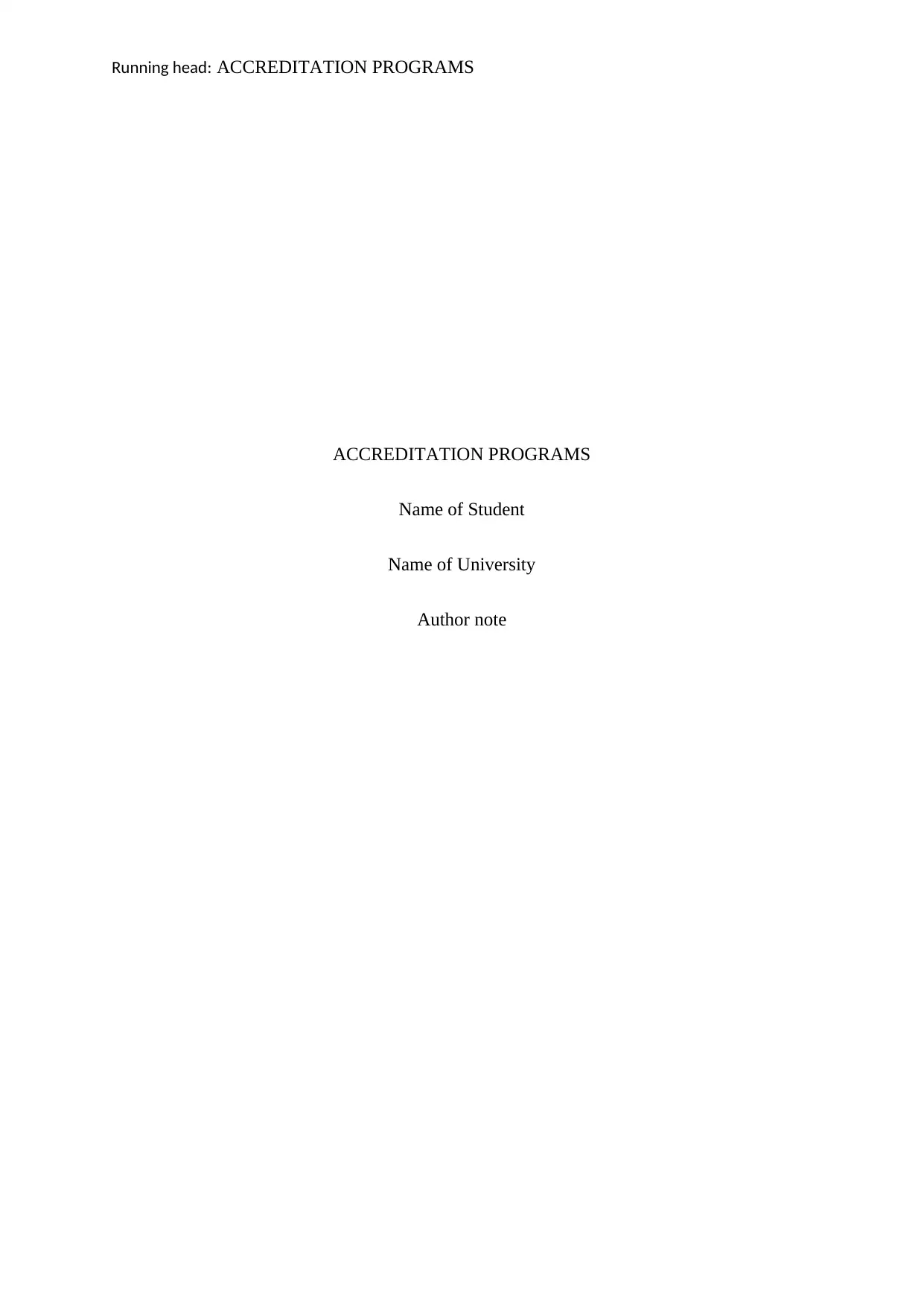
Running head: ACCREDITATION PROGRAMS
ACCREDITATION PROGRAMS
Name of Student
Name of University
Author note
ACCREDITATION PROGRAMS
Name of Student
Name of University
Author note
Secure Best Marks with AI Grader
Need help grading? Try our AI Grader for instant feedback on your assignments.
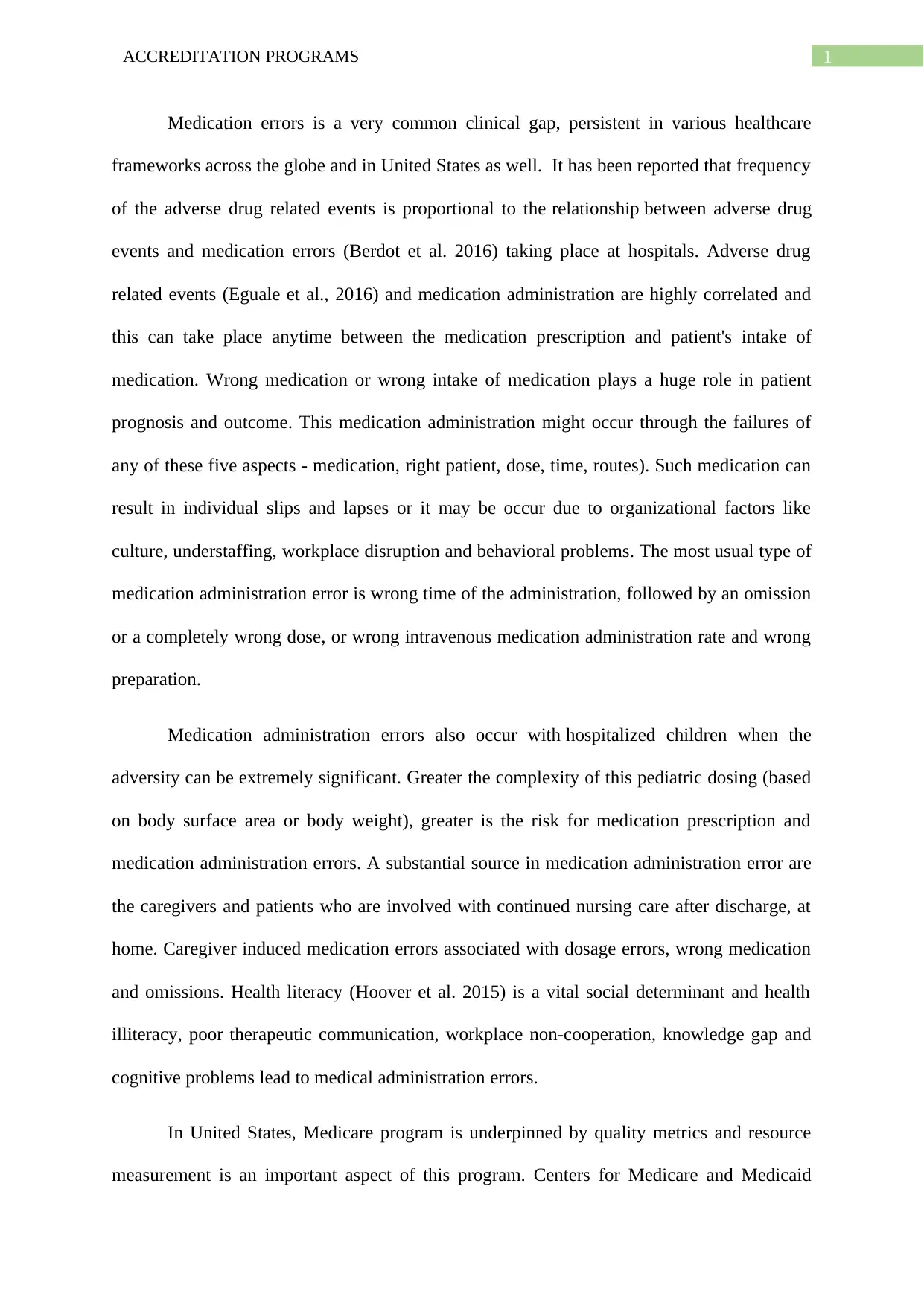
1ACCREDITATION PROGRAMS
Medication errors is a very common clinical gap, persistent in various healthcare
frameworks across the globe and in United States as well. It has been reported that frequency
of the adverse drug related events is proportional to the relationship between adverse drug
events and medication errors (Berdot et al. 2016) taking place at hospitals. Adverse drug
related events (Eguale et al., 2016) and medication administration are highly correlated and
this can take place anytime between the medication prescription and patient's intake of
medication. Wrong medication or wrong intake of medication plays a huge role in patient
prognosis and outcome. This medication administration might occur through the failures of
any of these five aspects - medication, right patient, dose, time, routes). Such medication can
result in individual slips and lapses or it may be occur due to organizational factors like
culture, understaffing, workplace disruption and behavioral problems. The most usual type of
medication administration error is wrong time of the administration, followed by an omission
or a completely wrong dose, or wrong intravenous medication administration rate and wrong
preparation.
Medication administration errors also occur with hospitalized children when the
adversity can be extremely significant. Greater the complexity of this pediatric dosing (based
on body surface area or body weight), greater is the risk for medication prescription and
medication administration errors. A substantial source in medication administration error are
the caregivers and patients who are involved with continued nursing care after discharge, at
home. Caregiver induced medication errors associated with dosage errors, wrong medication
and omissions. Health literacy (Hoover et al. 2015) is a vital social determinant and health
illiteracy, poor therapeutic communication, workplace non-cooperation, knowledge gap and
cognitive problems lead to medical administration errors.
In United States, Medicare program is underpinned by quality metrics and resource
measurement is an important aspect of this program. Centers for Medicare and Medicaid
Medication errors is a very common clinical gap, persistent in various healthcare
frameworks across the globe and in United States as well. It has been reported that frequency
of the adverse drug related events is proportional to the relationship between adverse drug
events and medication errors (Berdot et al. 2016) taking place at hospitals. Adverse drug
related events (Eguale et al., 2016) and medication administration are highly correlated and
this can take place anytime between the medication prescription and patient's intake of
medication. Wrong medication or wrong intake of medication plays a huge role in patient
prognosis and outcome. This medication administration might occur through the failures of
any of these five aspects - medication, right patient, dose, time, routes). Such medication can
result in individual slips and lapses or it may be occur due to organizational factors like
culture, understaffing, workplace disruption and behavioral problems. The most usual type of
medication administration error is wrong time of the administration, followed by an omission
or a completely wrong dose, or wrong intravenous medication administration rate and wrong
preparation.
Medication administration errors also occur with hospitalized children when the
adversity can be extremely significant. Greater the complexity of this pediatric dosing (based
on body surface area or body weight), greater is the risk for medication prescription and
medication administration errors. A substantial source in medication administration error are
the caregivers and patients who are involved with continued nursing care after discharge, at
home. Caregiver induced medication errors associated with dosage errors, wrong medication
and omissions. Health literacy (Hoover et al. 2015) is a vital social determinant and health
illiteracy, poor therapeutic communication, workplace non-cooperation, knowledge gap and
cognitive problems lead to medical administration errors.
In United States, Medicare program is underpinned by quality metrics and resource
measurement is an important aspect of this program. Centers for Medicare and Medicaid
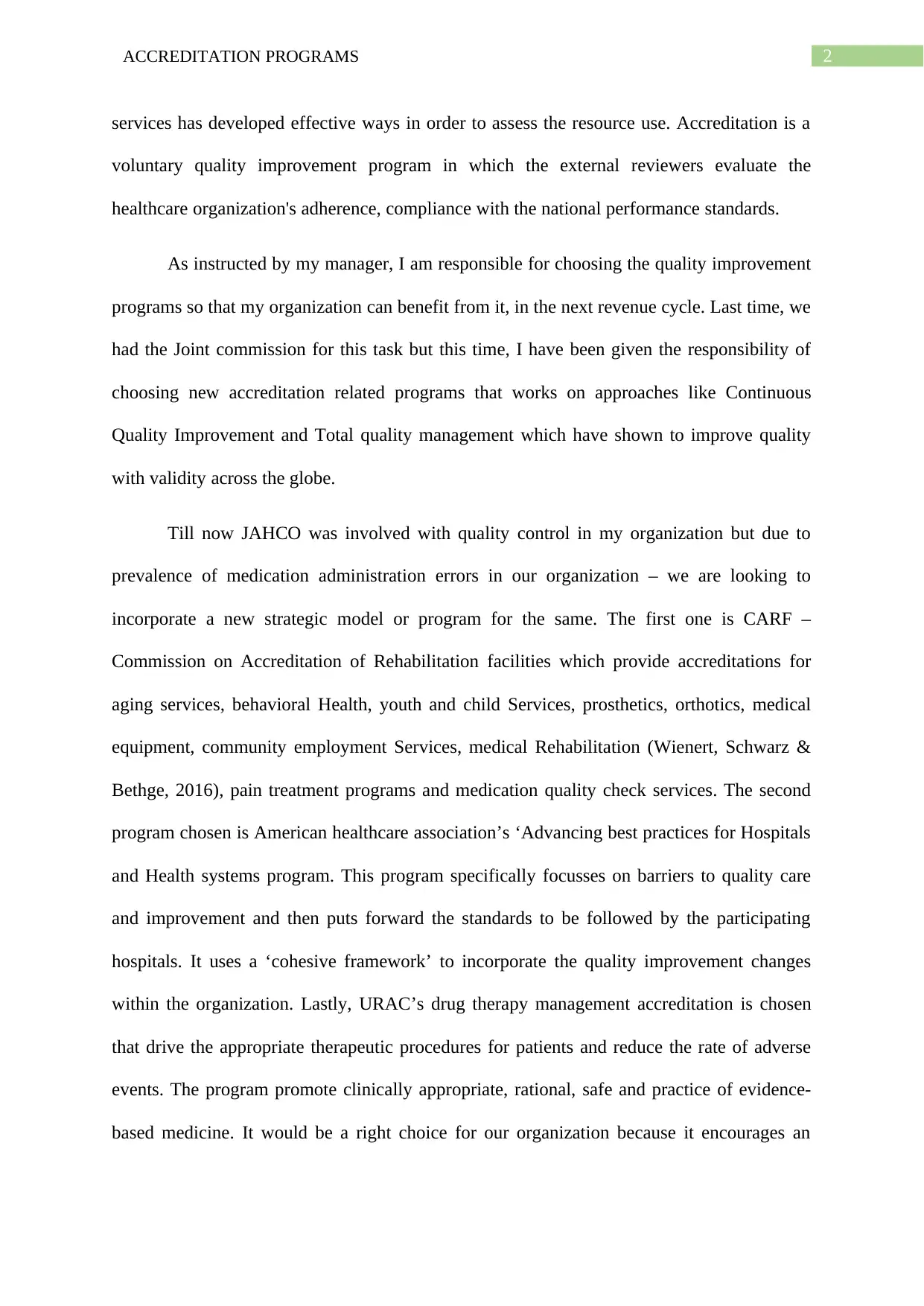
2ACCREDITATION PROGRAMS
services has developed effective ways in order to assess the resource use. Accreditation is a
voluntary quality improvement program in which the external reviewers evaluate the
healthcare organization's adherence, compliance with the national performance standards.
As instructed by my manager, I am responsible for choosing the quality improvement
programs so that my organization can benefit from it, in the next revenue cycle. Last time, we
had the Joint commission for this task but this time, I have been given the responsibility of
choosing new accreditation related programs that works on approaches like Continuous
Quality Improvement and Total quality management which have shown to improve quality
with validity across the globe.
Till now JAHCO was involved with quality control in my organization but due to
prevalence of medication administration errors in our organization – we are looking to
incorporate a new strategic model or program for the same. The first one is CARF –
Commission on Accreditation of Rehabilitation facilities which provide accreditations for
aging services, behavioral Health, youth and child Services, prosthetics, orthotics, medical
equipment, community employment Services, medical Rehabilitation (Wienert, Schwarz &
Bethge, 2016), pain treatment programs and medication quality check services. The second
program chosen is American healthcare association’s ‘Advancing best practices for Hospitals
and Health systems program. This program specifically focusses on barriers to quality care
and improvement and then puts forward the standards to be followed by the participating
hospitals. It uses a ‘cohesive framework’ to incorporate the quality improvement changes
within the organization. Lastly, URAC’s drug therapy management accreditation is chosen
that drive the appropriate therapeutic procedures for patients and reduce the rate of adverse
events. The program promote clinically appropriate, rational, safe and practice of evidence-
based medicine. It would be a right choice for our organization because it encourages an
services has developed effective ways in order to assess the resource use. Accreditation is a
voluntary quality improvement program in which the external reviewers evaluate the
healthcare organization's adherence, compliance with the national performance standards.
As instructed by my manager, I am responsible for choosing the quality improvement
programs so that my organization can benefit from it, in the next revenue cycle. Last time, we
had the Joint commission for this task but this time, I have been given the responsibility of
choosing new accreditation related programs that works on approaches like Continuous
Quality Improvement and Total quality management which have shown to improve quality
with validity across the globe.
Till now JAHCO was involved with quality control in my organization but due to
prevalence of medication administration errors in our organization – we are looking to
incorporate a new strategic model or program for the same. The first one is CARF –
Commission on Accreditation of Rehabilitation facilities which provide accreditations for
aging services, behavioral Health, youth and child Services, prosthetics, orthotics, medical
equipment, community employment Services, medical Rehabilitation (Wienert, Schwarz &
Bethge, 2016), pain treatment programs and medication quality check services. The second
program chosen is American healthcare association’s ‘Advancing best practices for Hospitals
and Health systems program. This program specifically focusses on barriers to quality care
and improvement and then puts forward the standards to be followed by the participating
hospitals. It uses a ‘cohesive framework’ to incorporate the quality improvement changes
within the organization. Lastly, URAC’s drug therapy management accreditation is chosen
that drive the appropriate therapeutic procedures for patients and reduce the rate of adverse
events. The program promote clinically appropriate, rational, safe and practice of evidence-
based medicine. It would be a right choice for our organization because it encourages an
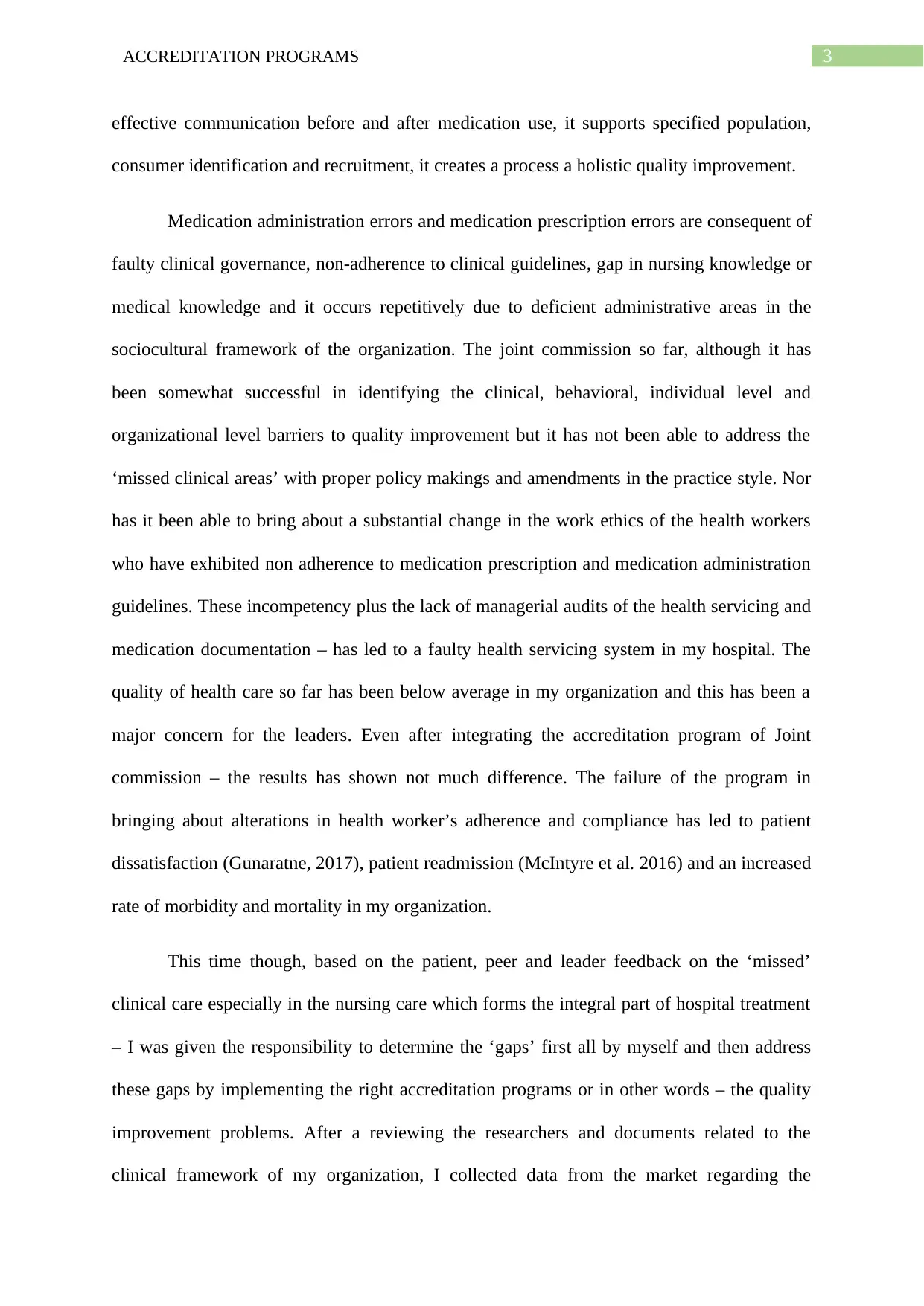
3ACCREDITATION PROGRAMS
effective communication before and after medication use, it supports specified population,
consumer identification and recruitment, it creates a process a holistic quality improvement.
Medication administration errors and medication prescription errors are consequent of
faulty clinical governance, non-adherence to clinical guidelines, gap in nursing knowledge or
medical knowledge and it occurs repetitively due to deficient administrative areas in the
sociocultural framework of the organization. The joint commission so far, although it has
been somewhat successful in identifying the clinical, behavioral, individual level and
organizational level barriers to quality improvement but it has not been able to address the
‘missed clinical areas’ with proper policy makings and amendments in the practice style. Nor
has it been able to bring about a substantial change in the work ethics of the health workers
who have exhibited non adherence to medication prescription and medication administration
guidelines. These incompetency plus the lack of managerial audits of the health servicing and
medication documentation – has led to a faulty health servicing system in my hospital. The
quality of health care so far has been below average in my organization and this has been a
major concern for the leaders. Even after integrating the accreditation program of Joint
commission – the results has shown not much difference. The failure of the program in
bringing about alterations in health worker’s adherence and compliance has led to patient
dissatisfaction (Gunaratne, 2017), patient readmission (McIntyre et al. 2016) and an increased
rate of morbidity and mortality in my organization.
This time though, based on the patient, peer and leader feedback on the ‘missed’
clinical care especially in the nursing care which forms the integral part of hospital treatment
– I was given the responsibility to determine the ‘gaps’ first all by myself and then address
these gaps by implementing the right accreditation programs or in other words – the quality
improvement problems. After a reviewing the researchers and documents related to the
clinical framework of my organization, I collected data from the market regarding the
effective communication before and after medication use, it supports specified population,
consumer identification and recruitment, it creates a process a holistic quality improvement.
Medication administration errors and medication prescription errors are consequent of
faulty clinical governance, non-adherence to clinical guidelines, gap in nursing knowledge or
medical knowledge and it occurs repetitively due to deficient administrative areas in the
sociocultural framework of the organization. The joint commission so far, although it has
been somewhat successful in identifying the clinical, behavioral, individual level and
organizational level barriers to quality improvement but it has not been able to address the
‘missed clinical areas’ with proper policy makings and amendments in the practice style. Nor
has it been able to bring about a substantial change in the work ethics of the health workers
who have exhibited non adherence to medication prescription and medication administration
guidelines. These incompetency plus the lack of managerial audits of the health servicing and
medication documentation – has led to a faulty health servicing system in my hospital. The
quality of health care so far has been below average in my organization and this has been a
major concern for the leaders. Even after integrating the accreditation program of Joint
commission – the results has shown not much difference. The failure of the program in
bringing about alterations in health worker’s adherence and compliance has led to patient
dissatisfaction (Gunaratne, 2017), patient readmission (McIntyre et al. 2016) and an increased
rate of morbidity and mortality in my organization.
This time though, based on the patient, peer and leader feedback on the ‘missed’
clinical care especially in the nursing care which forms the integral part of hospital treatment
– I was given the responsibility to determine the ‘gaps’ first all by myself and then address
these gaps by implementing the right accreditation programs or in other words – the quality
improvement problems. After a reviewing the researchers and documents related to the
clinical framework of my organization, I collected data from the market regarding the
Secure Best Marks with AI Grader
Need help grading? Try our AI Grader for instant feedback on your assignments.

4ACCREDITATION PROGRAMS
efficiency of other healthcare quality improvement accreditation programs and finally chose
the three programs as mentioned above for they have the right ‘principles’ to address my
organization’s specified quality problems. The chosen programs will be impacted by
sociocultural, political requirement but surely, these are great options to explore and they can
perhaps, contest with Joint commission for a replacement. The programs has distinct features
and unique ways of addressing the quality improvement areas that will surely be helpful.
efficiency of other healthcare quality improvement accreditation programs and finally chose
the three programs as mentioned above for they have the right ‘principles’ to address my
organization’s specified quality problems. The chosen programs will be impacted by
sociocultural, political requirement but surely, these are great options to explore and they can
perhaps, contest with Joint commission for a replacement. The programs has distinct features
and unique ways of addressing the quality improvement areas that will surely be helpful.
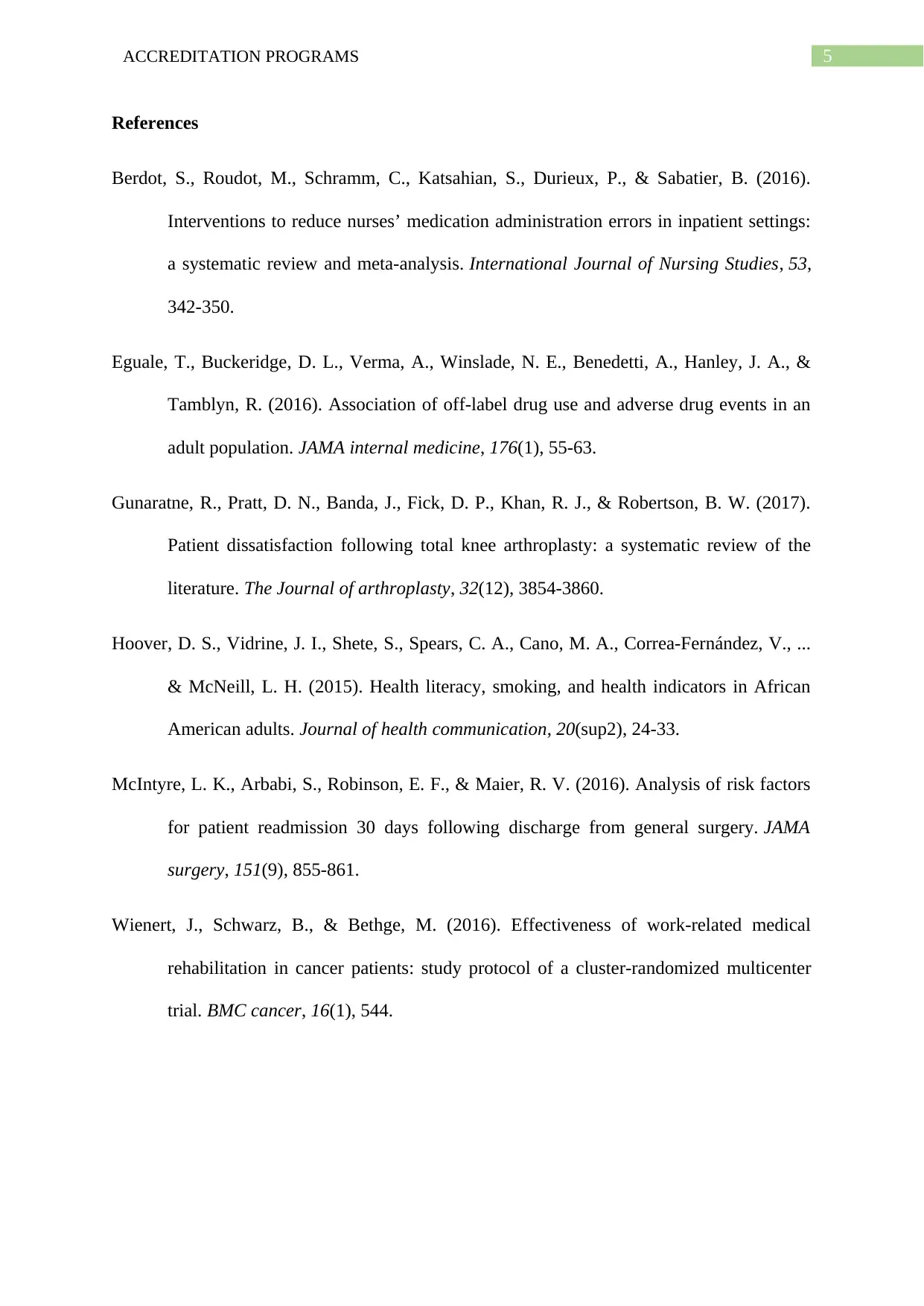
5ACCREDITATION PROGRAMS
References
Berdot, S., Roudot, M., Schramm, C., Katsahian, S., Durieux, P., & Sabatier, B. (2016).
Interventions to reduce nurses’ medication administration errors in inpatient settings:
a systematic review and meta-analysis. International Journal of Nursing Studies, 53,
342-350.
Eguale, T., Buckeridge, D. L., Verma, A., Winslade, N. E., Benedetti, A., Hanley, J. A., &
Tamblyn, R. (2016). Association of off-label drug use and adverse drug events in an
adult population. JAMA internal medicine, 176(1), 55-63.
Gunaratne, R., Pratt, D. N., Banda, J., Fick, D. P., Khan, R. J., & Robertson, B. W. (2017).
Patient dissatisfaction following total knee arthroplasty: a systematic review of the
literature. The Journal of arthroplasty, 32(12), 3854-3860.
Hoover, D. S., Vidrine, J. I., Shete, S., Spears, C. A., Cano, M. A., Correa-Fernández, V., ...
& McNeill, L. H. (2015). Health literacy, smoking, and health indicators in African
American adults. Journal of health communication, 20(sup2), 24-33.
McIntyre, L. K., Arbabi, S., Robinson, E. F., & Maier, R. V. (2016). Analysis of risk factors
for patient readmission 30 days following discharge from general surgery. JAMA
surgery, 151(9), 855-861.
Wienert, J., Schwarz, B., & Bethge, M. (2016). Effectiveness of work-related medical
rehabilitation in cancer patients: study protocol of a cluster-randomized multicenter
trial. BMC cancer, 16(1), 544.
References
Berdot, S., Roudot, M., Schramm, C., Katsahian, S., Durieux, P., & Sabatier, B. (2016).
Interventions to reduce nurses’ medication administration errors in inpatient settings:
a systematic review and meta-analysis. International Journal of Nursing Studies, 53,
342-350.
Eguale, T., Buckeridge, D. L., Verma, A., Winslade, N. E., Benedetti, A., Hanley, J. A., &
Tamblyn, R. (2016). Association of off-label drug use and adverse drug events in an
adult population. JAMA internal medicine, 176(1), 55-63.
Gunaratne, R., Pratt, D. N., Banda, J., Fick, D. P., Khan, R. J., & Robertson, B. W. (2017).
Patient dissatisfaction following total knee arthroplasty: a systematic review of the
literature. The Journal of arthroplasty, 32(12), 3854-3860.
Hoover, D. S., Vidrine, J. I., Shete, S., Spears, C. A., Cano, M. A., Correa-Fernández, V., ...
& McNeill, L. H. (2015). Health literacy, smoking, and health indicators in African
American adults. Journal of health communication, 20(sup2), 24-33.
McIntyre, L. K., Arbabi, S., Robinson, E. F., & Maier, R. V. (2016). Analysis of risk factors
for patient readmission 30 days following discharge from general surgery. JAMA
surgery, 151(9), 855-861.
Wienert, J., Schwarz, B., & Bethge, M. (2016). Effectiveness of work-related medical
rehabilitation in cancer patients: study protocol of a cluster-randomized multicenter
trial. BMC cancer, 16(1), 544.
1 out of 6
Related Documents
Your All-in-One AI-Powered Toolkit for Academic Success.
+13062052269
info@desklib.com
Available 24*7 on WhatsApp / Email
![[object Object]](/_next/static/media/star-bottom.7253800d.svg)
Unlock your academic potential
© 2024 | Zucol Services PVT LTD | All rights reserved.





